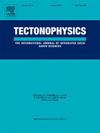Anisotropy of the thermal conductivity, thermal expansion coefficient, and seismic wave velocity in the oceanic lithosphere–asthenosphere system
IF 2.6
3区 地球科学
Q2 GEOCHEMISTRY & GEOPHYSICS
引用次数: 0
Abstract
Previous numerical studies have considered complex material properties in investigations of the thermal structure of oceanic plates, although the properties are assumed to be isotropic. This study focused on anisotropic thermal conductivity and expansion coefficients related to the crystallographic-preferred orientation of mantle minerals, and the effects of this anisotropy on the thermal structure of oceanic plates and associated surface heat flow, seafloor subsidence, and seismic anisotropy. A steady-state temperature and rock flow velocity are obtained in a two-dimensional model domain near a mid-ocean ridge. The results show that anisotropic thermal conductivity increases the mantle temperature by up to 18–28 K for oceanic crust with an age of 60 Myr, depending on the assumed half-spreading rate, because the vertical component of the conductivity is lower than the isotropic value. The effects on surface heat flow are minor. Anisotropy of the thermal expansion coefficient results in a small increase in seafloor subsidence, as the vertical component of the thermal expansion coefficient is higher than the isotropic case. Incorporating the effects of enstatite leads to a reduced anisotropy for the thermal conductivity and expansion coefficient. The increase in mantle viscosity due to dehydration associated with partial melting has a large effect on the seismic anisotropy. This leads to an abrupt, largely age-independent increase in azimuthal and radial anisotropy at 60 km depth, which may explain some seismic observations.
海洋岩石圈-软流圈系统中热导率、热膨胀系数和地震波速度的各向异性
以前的数值研究在研究海洋板块的热结构时考虑了复杂的材料性质,尽管这些性质被假定为各向同性。本研究重点研究了与地幔矿物晶体优选取向相关的各向异性导热系数和膨胀系数,以及这种各向异性对大洋板块热结构及其相关的表面热流、海底沉降和地震各向异性的影响。在海洋中脊附近的二维模型域中,得到了稳态温度和岩石流速。结果表明,各向异性热导率使年龄为60 Myr的海洋地壳的地幔温度升高了18 ~ 28 K,这取决于假定的半扩张速率,因为热导率的垂直分量低于各向同性值。对表面热流的影响很小。热膨胀系数的各向异性导致海底沉降增加较小,因为热膨胀系数的垂直分量高于各向同性情况。结合顽辉石的影响,降低了导热系数和膨胀系数的各向异性。部分熔融脱水引起的地幔黏度增加对地震各向异性有很大影响。这导致在~ 60 km深度处方位和径向各向异性的突然增加,很大程度上与年龄无关,这可以解释一些地震观测结果。
本文章由计算机程序翻译,如有差异,请以英文原文为准。
求助全文
约1分钟内获得全文
求助全文
来源期刊

Tectonophysics
地学-地球化学与地球物理
CiteScore
4.90
自引率
6.90%
发文量
300
审稿时长
6 months
期刊介绍:
The prime focus of Tectonophysics will be high-impact original research and reviews in the fields of kinematics, structure, composition, and dynamics of the solid arth at all scales. Tectonophysics particularly encourages submission of papers based on the integration of a multitude of geophysical, geological, geochemical, geodynamic, and geotectonic methods
 求助内容:
求助内容: 应助结果提醒方式:
应助结果提醒方式:


